![]()
![]()
![]()
Use LEFT and RIGHT arrow keys to navigate between flashcards;
Use UP and DOWN arrow keys to flip the card;
H to show hint;
A reads text to speech;
67 Cards in this Set
- Front
- Back
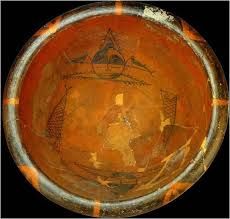
|
ID: Bowl, Neolithic Period, 4000BCE, Yangshao Culture, Banpo Village, (near Xi'an, Shaanxi province)
Subject: bowl decorated with 2 fish (hunting and fishing society), 2 human masks (Shaman priests)
Style: simple shape and design (motifs are recognizable, but not naturalistic and they are geometric pattern motifs)
Material: painted pottery; low-fired clay
Technique: coil-built and slip paint
Purpose: bowl
Cultural Tradition: Yangshao |
|
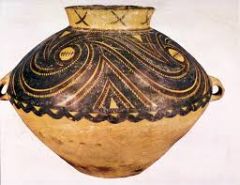
|
ID: Funerary Jar, Neolithic Period, 2400BCE, Yangshao Culture, Banshan site (Gansu province)
Subject: burial urn
Style: geometric and wavy patterns; bottom left unpainted
Material: painted pottery using low-fired clay and slip paint
Technique: coil-built and slip paint
Purpose: used for burial purposes
Cultural Tradition: Yangshao Culture
|
|
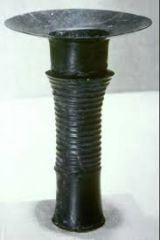
|
ID: Gu Beaker, Neolithic Period, 2000BCE, Longshan Culture, Lower Yellow River Valley
Subject: black pottery
Style: even form, smooth surface, very thin wall
Material: unpainted pottery, clay
Technique: wheelthrown on a potter's wheel
Function: used to contain wine; ritual purposes
Cultural tradition: Longshan |
|
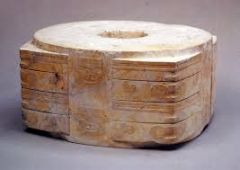
|
ID: Cong, Neolithic Period, 2700-2200BCE, Liangzhu Culture, Lower Yangzi River Valley
Subject: squared ritual tube, decorated with masks
Style: short, square shape outside represents heaven and circular shape inside represents earth
Material: Jade (extremely hard stone)
Technique: advanced carving
Purpose: used in ritual ceremony (cong = earth and bi = heaven)
Cultural tradition: Liangzhu culture |
|
|
Yellow River |
top river
flowed north
bordered Shaanxi and Henan provinces |
|
|
Yangzi River |
(Long) river
lower river
divides China into North and South (different cultures) |
|
|
slip paint |
mix of clay and water that was applied to surface of clay |
|
|
handbuilt |
working with clay using hands and simple tools |
|
|
wheelthrown |
uses a pottery wheel to sculpt clay |
|
|
The Era of Dragons and Pheonixes |
Totems of Remote Antiquity Ritual and magic rites Pheonix and Dragon represent deities Dragon with snake and pheonix with bird Clan totems are interconnected Fish: long, unending prosperity and fertility Coils: connect to snake Geometic patterns: peaceful society Wave patterns: violence/unorder society |
|
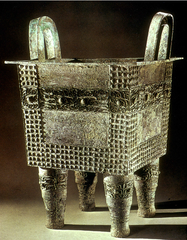
|
ID: Square Ding Ritual Vessel, Shang Dynasty, 16th-14th BCE century, Zhengzhou (Early Shang Style)
Subject: food vessel, 2 handles, 4 legs, square shape
Style: taotie motif; Max Loehr Style 1: narrow band with taotie motif organized along it and raised/threadlike area; simple form
Material: bronze
Technique: piece mold casting technique
Purpose: ritual food vessel
Cultural Tradition: Zhengzhou |
|

|
ID: Square Ding Ritual Vessel inscribed with "Fu Hao", Shang Dynasty, 1200BCE, Anyang (Late Shang Style), Tomb of Fu Hao
Subject: 2 handles, 4 legs, food vessel, curled "dragon" shaped legs, kingly power
Style: Max Loehr Style 5: covers entire surface, motif is more defined, highly raised; Lewien: thunder pattern motif in background; Kuilong: Kui dragon motif (half taotie- deified snake); inscribed with "Fu Hao"
Material: bronze
Technique: piece-mold casting technique
Purpose: ritual food vessel that was probably used during her lifetime
Cultural tradition: Anyang |
|
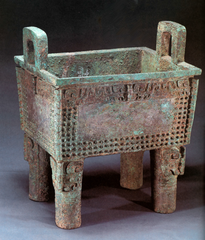
|
ID: Square Ding Ritual Vessel inscribed with "Si Mu Xin", Shang Dynasty, 1200 BCE, Anyang (Late Shang Style), Tomb of Fu Hao
Subject: 2 handles, 4 legs, food vessel, kingly power
Style: Max Loehr Style 5: highly raised, taotie motif on leg, Kuilong and lei wen motif on body (but on a narrow band which isn't normal), clearly identifiable motifs, inscribed with "Si Mu Xin" (Queen Mother Xin)
Material: bronze
Technique: piece-mold casting
Purpose: ritual food vessel that was made for her tomb
Cultural Tradition: Anyang |
|
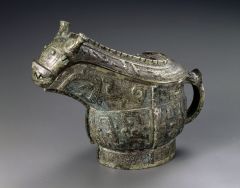
|
ID: Guang Ritual Vessel inscribed with "Fu Hao", Shang Dynasty, 1200BCE, Anyang (Late Shang Style), Tomb of Fu Hao
Subject: wine vessel, handle on one side
Style: Max Loehr Style 5: raised, Leiwen pattern in background, composite animals (tiger in front, owl in back, snake from bottom) motif; inscribed with Fu Hao
Material: bronze
Technique: piece mold casting
Purpose: ritual wine vessel that was used during her lifetime
Cultural Tradition: Anyang |
|

|
ID: Figure on Stand, Shang Dynasty, 1200-1000BCE, Sanxingdui (Late Shang Style), Upper Yangzi
Subject: person standing on a pedastel, 2 hands were probably holding weapons, 260cm tall, depiction of a diety
Style: 1st pedastel is decorated with animal heads, wearing a crown and 2 layers of garment with elaborate designs (influence from Middle East); sharply defined face (big eyes, square chin, large ears, straight nose); ill-proportioned (not naturalistic- slim body, stiff posture, large hands)
Material: bronze
Technique: piece mold casting
Purpose:
Cultural Tradition: Late Shang |
|
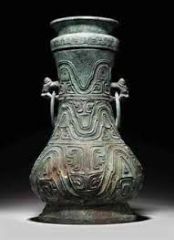
|
ID: Hu Ritual Vessel, Zhou Dynasty, 9th century BCE, Western Zhou
Subject: water vessel, inscriptions, has a foot/lid and two handles
Style: inscription: a wedding gift from a father to his child; geometric patterns: wavy/curvy lines which are replacing motifs
Material: bronze
Technique: piece mold casting and inscriptions
Purpose: ritual water vessel
Cultural Tradition: Western Zhou |
|
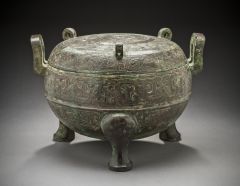
|
ID: Ding Ritual Vessel, Zhou Dynasty, 4th-3rd century BCE, Eastern Zhou
Subject: food vessel, round shape body, 3 legs, 2 handles, light (easy to carry)
Style: elaborate decorations (dragon motifs- inlaid with silver, spiral motif on the bottom, interlocking triangles- interlacing dragons which is associated with Western Asia
Material: bronze inlaid with silver
Technique: inlaid technique and lost-wax method
Purpose: food vessel for daily use
Cultural Tradition: Eastern Zhou |
|

|
ID: Mirror, Zhou Dynasty, 3rd century BCE, Eastern Zhou
Subject: mirror with handle in center to hold
Style: geometric motifs, man riding a horse holding a sharp sword confronting a tiger-like creature (generalized), blank/empty backgrounds (generalism)
Material: bronze inlaid with gold and silver
Technique: inlaid technique and lost-wax method
Purpose: mirror
Cultural Tradition: Eastern Zhou |
|
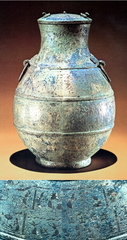
|
ID: Hu Vessel with Banqueting Scenes, Zhou Dynasty, 6th-5th century BCE, Eastern Zhou
Subject: lid with two handles, robust form (revival of elaboration
Style: progressive (generalized); human detail and activity (hybrid creatures)- banqueting, hunting, archery, mulberry picking (associated with Southern Chu culture); secular interests
Material: bronze with inlay
Technique: inlaid technique and it is argued if it is piece mold casting or lost-wax
Purpose: water vessel
Cultural Tradition: Eastern Zhou |
|
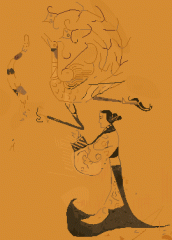
|
ID: Lady with Pheonix and Dragon, Zhou Dynasty, 3rd century BCE, Eastern Zhou, State of Chu- tomb of Chngsha, Henan
Subject: woman figure with pheonix/dragon figures coming out of her arms
Style: gender of figure is identical to gender of owner of tomb (female); pheonix and dragon are dieties that help guide her soul into heaven
Material: ink on silk
Technique: chinese painting
Purpose: buried with her to help guide her to afterlife
Cultural Tradition: Eastern Zhou |
|
|
Oracle Bones |
"Dragon bones" or "Di" Inscriptions are earliest Chinese writing system Divinations Found in Anyang sites People ate bones- mythical powers Ox shoulder or turtle shell (smooth for carving) Burn inscriptons in- bones crack Cracks were the oracles that diviners would read Once read, inscribe the message on bone Used for ancestral worship
|
|
|
Divinations |
Zhenren- diviner Spritual communication with deities |
|
|
Taotie |
Glutton (eat and drink excessively) Mask of an ogre Shoumian (animal mask) Totem used to scare the enemy Used to evoke mystery and fear Sacred ox (protect against evil) Communicate mystery/power/terror/ferocity Dual nature- protect people and eat enemy Charming/childish/naive/primitive/simple |
|
|
Kuilong |
Dragon pattern motif Associated with Zhou Dynasty |
|
|
Leiwen |
Thunder pattern motif Associated with Zhou Dynasty |
|
|
Mandate of Heaven |
Heaven granted emperors right to rule based on their ability to govern well and fairly
If no longer emperor, lost the Mandate
|
|
|
Max Loehr's Five Style of Shang Bronze Decoration |
Style 1 (Zhengzhou): organized along a narrow band (don't cover entire surface); not well-defined; very shallow carvings (raised is thin- threadlike)
Style 2 (Zhengzhou): organized along a narrow band (don't cover entire surface); not well-defined; very shallow carvings (raised is more broad)
Style 3: can either be closer to 1&2 or 4&5
Style 4 (Anyang): well-defined and identifiable motifs; covers most/all of vessel; thunder pattern and Kuilong motifs, deeper carvings
Style 5 (Anyang): well-defined and identifiable motifs; covers most/all of vessel; thunder pattern and Kuilong motifs, deeper carvings (more highly raised) |
|
|
Guo Moruo's Four Stages of Shang and Zhou Bronzes |
1) Excessive production of wine cups (Early Shang- Zhengzhou)
2) Prosperity for bronzes- zenith of Chinese bronze art (Late Shang- Anyang)
3) The open stage- disenegration and ideological emancipation (Late Western Zhou-Spring and Autumn Period)
4) New style stage: decline of religion and magical rites- progressive: revival of elaboration and human interests and degenerate: declining tradition (Warring States Period) |
|
|
State of Chu |
In southern Yangzte Valley- Yellow River basin During Zhou period Snakes/dragons/pheonixes/tigers/clouds |
|
|
Confucianism |
Importance of individuals- self-cultivation and education
Find your place in society and fufill duties Human Relationships
Filal piety: serving elders in your family
Associated with Mandate of Heaven
Founded by Confucious
Human goodness |
|
|
Confucious |
Kongzi 551BCE-479BCE Founded Confucianism
Emphasized personal and governmental morality, correctness of social relationships, justice and sincerity
Family loyalty and ancestral worship |
|
|
Daoism |
Founded by Laozi Late 6th century BCE Live in harmony with the Tao ("the Way") Guidlines for human life in nature
Tao denotes something that is both the source of, and the force behind, everything that exists
Wu-wei (action through non-action), naturalness, simplicity, spontaneity, and the Three Treasures: compassion, moderation, and humility. |
|
|
Laozi |
Founded Taoism Late 6th century BCE Revered as a deity in religious Taoism |
|
|
Legalism |
People are hopeless Rule by strict law and harsh punishment Caused the decline of Qin Dynasty |
|
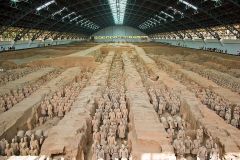
|
ID: Pit 1 with burial army, Qin Dynasty, 210 BCE, Tomb of Qin Shihuangdi at Mt. Li
Subject: 6000 life-size soldiers organized in battle formation; infantrymen/calvarymen/archers/war chariots/charioteers; standing on low clay plates;
Style: orgnized in 11 corridors; dressed in armor; holding weapons; stiff, frontal posture (hollow) with no sense of body movement; facial features are individualized; more complicated headgear = higher ranking; orginally painted with rich colors
Material: low-fired clay/terracotta/earthernware; painted
Technique: used clay molds for body parts and assembled and indvidualized after firing in kiln
Purpose: functioned to protect emperor in his afterlife
Patron: First emperor, Qin Shihuangdi, for his tomb
|
|
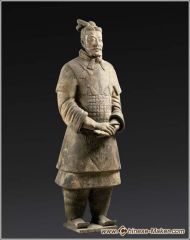
|
ID: General, Qin Dynasty, 210 BCE, Tomb of Qin Shihuangdi at Mt. Li
Subject: highest ranking officer (one of six), standing on low clay plate
Style: stiff body; solid legs support hollow body, wearing full body armor over a layer of garment and chest is decorated with tassels; shoes have front part protruding which denotes officer, looks to be old in age (senior officer), headgear: bird wing protrusion signifies highest rank
Material: earthenware/low-fired clay
Technique: body parts were made using a mold and then assembled and indvidualized after firing in kiln
Purpose: help guard first emperor in his afterlife
Patron: First emperor, Qin Shihuangdi, for his tomb |
|
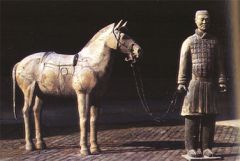
|
ID: Horse and calvaryman, Qin Dynasty, 210 BCE, Tomb of Qin Shihuangdi at Mt. Li
Subject: man holding a horse, standing on a low clay plate
Style: solid legs support hollow body, indvidualized facial features, wearing armor, naturalistic depiction of horse
Material: low-fired clay
Technique: used molds for body parts and assembled after firing in the kiln
Purpose: used to guard the emperor in his afterlife
Patron: First emperor, Qin Shihuangdi, for his tomb |
|
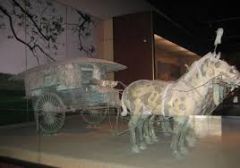
|
ID: Carriage and horses, Qin Dynasty, 210 BCE, Tomb of Qin Shihuangdi at Mt. Li
Subject: 2 wheeled carriage drawn by four horses, umbrella like support, entrance at back, windows, luxurious items found inside and on horses
Style: cloud/geometric pattern motif, half-life size, was originally painted
Material: bronze with painted decoration
Technique: bronze casting method (lost-wax?)
Purpose: vehicle for emperor in afterlife
Patron: First emperor, Qin Shihuangdi, for his tomb |
|
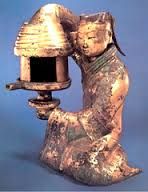
|
ID: Lamp Held by Kneeling Servant Girl, Han Dynasty, 2nd century BCE (173 BCE), Western Han, Tomb of Dou Wan
Subject: girl holding a lamp; inscription: gift from imperial court to Dou Wan during her lifetime
Style: girl is wearing a long garment with broad sleeves (what a palace lady may have worn); facial feature are generalized, but seem to have worry/concern (palace life was not good); no decoration but beauty is conveyed through 3-D form
Material: gilt bronze
Technique: lost-wax method and gilt bronze technique
Purpose: lamp; has a sliding door to adjust direction and amount of light; remains of whatever burned would fall into the girl's body and then could be cleaned out
Cultural Tradition: Western Han |
|
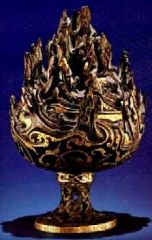
|
ID: Fairy Mountain Incense Burner, Han Dynasty, 2nd century BCE (113 BCE), Western Han, Tomb of Liu Sheng
Subject: inscription: "Boshan Xianglu"- Universal Mountain Censer; 3-D sculpture
Style: elegant; graceful; 3-D; mountain peaks above an ocean supported by dragonlike creatures; wavy motif: represent ocean
Material: bronze inlaid with gold
Technique: inlaid technique (gold is of different widths)
Purpose: to burn incense- holes behind each mountain peak (yunqi: cloud vapor- vital force of universe)
Cultural Tradition: Western Han |
|

|
ID: Funerary Banner, Han Dynasty, 2nd century BCE (180BCE), Western Han, Tomb of Marquise of Dai
Subject: T-shaped banner; oldest cosmic depiction (heaven, earth, and underworld); woman with hunchback is likely Lady Dai
Style: toad- moon and crow-sun; dragon and hybrid creatures wrapping around a woman (Lady Dai's soul to help to go heaven); body is wrapped in silk (signifies Lady Dai's body); figures depicted against blank/empty background
Material: ink on silk
Technique: painting
Purpose: help guide Lady Dai into the afterlife
Cultural Tradition: Western Han and Chu |
|
|
Filal Piety |
Xiao Action of serving elders in your family
Five Relationships/Bonds 1. ruler and subject 2. father and son 3. husband and wife 4. elder and younger brothers 5. friend and friend
Han uses first three and adopt Confucian state philosophy |
|
|
Spirit Articles (mingqi) |
Variety of things manufactured for the afterlife |
|
|
Grave figurines (muyong) |
Items buried with an individual Helped construct a posthumous world Were used to furnish tombs Some had inscriptions Replaced human sacrafices Items would be used in person's afterlife Differed between South and North |
|
|
The Traditions of Qu Yuan |
China's earliest poet (Warring States Period)
Major work: Li Sao- righteous world of imagination, sentiment, richness, poignancy, and profoundess
Hated the social order
Tian Wen (Asking Heaven): mythical traditions compared to Pheonixes and Dragons
Chu Chi (songs of Chu)- made up a prominent romantic system 1. old style 2. linked to sacrafice and ancestral worship 3. feelings, imagination, and imagery 4. fu-style literature of Han Dynasty |
|
|
The Chu Culture Traditions |
Han Dynasty orginated in Chu
Early Chu burial offerings bronze vessels in the Zhou style. Later Chu burials, especially during the Warring States: burial objects, such as colorful lacquerware, iron, and silk
Motifs: wildlife, mystical animals, snakes, dragons, phoenixes, tigers, clouds and serpent-like beings.
Connections to the vanished Shang dynasty, since many motifs are similar
Downfall during Legalism of Qin dynasty
Culture was romanticized during Han Dynasty (songs of Chu) |
|
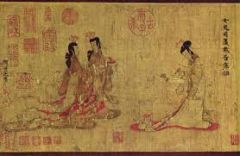
|
ID: The Admonitions of the Instructress to the Court Ladies, Six Dynasties Period, 317-420CE, Eastern Jin, Gu Kaizhi
Subject: Zhang Hua: confucian poem that teaches a court lady how to behave; pictorial depiction of a texutural passage
Style: handscroll; thin/slender/elongated body form; long layers of garment (sense of movement), generalized female court members (not naturalistic); graceful/elegant; blank/empty setting
Material: ink and color on silk
Technique: chinese painting: brushwork has fine/even outlines with even width/thickness
Purpose: tells court ladies what they should and shouldn't do
(v. 75-80): things you should and shouldn't do (v. 63-74): don't fight against each other to win a man's favor (v. 45-48): don't gossip or your husband may leave you (v. 25-28): woman would sacrafice her life for the emperor |
|
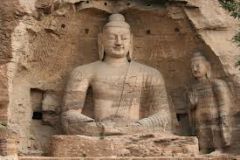
|
ID: Shakyamuni Buddha with Attendant Buddha (perhaps Maitreya), Six Dynasties Period, mid 5th century CE (460-465CE), Northern Wei, Yungang Cave 20
Subject: Buddhas of Three Times (Past, Present: Shakyamuni, and Future: Maitreya)
Style: Ghandara tradition influence (Kushan): heavy/thick garment, natural features, gigantism/colossal over detaila and proportion; flame pattern motif; decorative halos that are an indication of light (symbolic of teaching)
Material: sandstone
Technique: carved
Patron: Emperor sponsored cave because he considered himself to be of divine kingship (considered a living Buddha)
Icongraphy: Colassal, ushnisha, uma, elongated earlobes, monk scarf, dhyanamudra
Cultural tradition: Kushan influence |
|
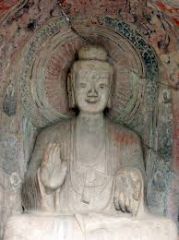
|
ID: Seated Buddha with Attendants, Six Dynasties Period, early 6th century (523CE), Northern Wei, Longmen Caves at Luoyang
Subject: Buddha of Three Times (standing buddha on either side of wall and seated in middle (picture)); two guardian figures at entrance; 4 bodhisattavas; 2 disciples
Style: slender face, slender/elongated body, long flowing garment (similar to that of Southern official court garment); similar to Gui Kaizhi figures
Material: limestone
Technique: carved
Patron: Emperor dedicated this to his late father who was responsible for cultural reforms; notion of divine kingship
Icongraphy: ushnisha, urna, elongated earlobes, lion throne, seated, abhayamudra, monk scarf |
|
|
Format of Chinese painting |
handscroll: horizantal (in drawer) hanging scroll: vertical (on wall) album leaf: photo album |
|
|
Xie He's Six Principles (Liu Fa) |
1. Qiyun Shengdong: "Spiritual Harmony"; "Life's motion"; "animation through spirit consonacnce"; full of life 2. Gufu yongbi: "bone- means use brush"; "structural method in use of brush" 3. Yingwu xiangxing: "fidelity to the object in portraying forms" 4. Suilei fucai: "conformity to kind in applying colors 5. Jinying weizhi: "proper planning in placing [of elements] 6. Chuanyi muxie: "that by copying, the ancient models should be perpetuated |
|
|
The Style of Wei and Jin |
Wei (220-265CE) and Jin (265-420CE)
Confucianism fell- focus on human development and theme
ideological and societal changes: new approach to art and literature
awakening of humankind (literature/art/aesthetics)
abtruse learning: Xuanxe (NeoDaoism)
concerned with life longevity
anxiety over life, death, survival, and extinction Cao Cao: 3rd century- happy Tao Qin: 365-427- be happy outwardly: grief and sorrow inwardly: an ardent love of life/living/future
New outlook on life: internal moral awakening
Signfigcance and value of individual existence- talent, characters, appearence, and manners |
|
|
Buddhism |
Buddha: Enlightened Being The state of being enlightened
Founded by Shakyamuni Buddha (Siddhartha Gautama) (563-483BCE) |
|
|
Karma |
action in this lifetime to determine rebirth |
|
|
Samsara |
endless cycle of birth and rebirth |
|
|
Nirvana |
(extinguishing)
the death of Buddha
to be one with the universe |
|
|
Shakyamuni |
one of the names for Buddha
usually present |
|
|
Sangha |
Buddhist community
monk, nun, layman, laywoman |
|
|
Dharma |
Buddhist Teaching
Four Noble Truths (first sermon) 1. All life is suffering 2. The cause of suffering is your desire 3. To stop suffering, stop desire 4. To follow Buddhist teaching |
|
|
Buddha |
Enlightened Being
Founded by Siddhartha Guatama -born in the Sakya Kingdom -the Sage of Shakya Clan -563-483BCE
|
|
|
Ushnisha |
a knot of hair |
|
|
Urna |
circular mark or tuft of hair inbetween eyebrows |
|
|
Mudra |
hand gesture |
|
|
Abhayamudra |
fear-not hand gesture
palm facing up and out |
|
|
Dhyanmudra |
gesture of meditation
hands folded in lap |
|

|
ID: Court Ladies with Flowers in their Hair, Tang Dynasty, 8th century CE, Zhou Fang
Subject: handscroll of two ladies with pet, lady followed by servant, and a woman with a tree holding a butterfly flower
Style: blank background so figures are major motif; elegant and graceful; rich colors and elaborate design of their garments; transparent garment with some parts of body exposed; fat beauty: long/narrow eyes, moth eyebrows, cherry blossom mouth, round face and shoulders
Material: handscroll; ink on silk
Technique: chinese painting
Cultural tradition: foreign influence because pet is not common to China nor is the garment/textile; also not common to expose body parts
|
|
|
Voice of Prime Tang |
Social changes: rise of landlord class (low-class) and fall of great families, developed economy, end of civil war, unity and stability (internal)
Art was youthful, expressive, emotional; focus on poetry (Li Bai); look towards nature of life (joyful opposed to sorrowful)
Objective: open to many interpretations
Central focus: officialdom (highest honor)- you can get something through your efforts; valued "crowns and glory"
Military exploration (external)
Cultural changes: music, calligraphy (cursive script) and (Zhang Xu: Sage of Grass Script)
Cheerful and flamboyant spirit
Unprecedented blending of past/present and foreign/Chinese |

